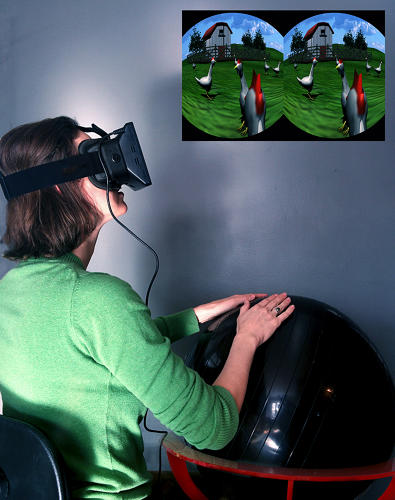By using a headset, a wall TV display and a yoga ball trackpad, Stewart demonstrated to people in Iowa and Ohio (including a number of farmers) how virtual free range would work for the farm animals. The chickens would be able to enjoy the sense of motion, waving grass, a free trees and even some virtual reality chickens to pal around with in the digital realm. Participants had the opportunity to try out the chicken simulation themselves and were very impressed by it if still confused about its true implications. One of participants asked how the chickens would feel about having no real, tangible interactions. That brought up what’s basically the whole point of the Second Livestock fictional company: to think about how virtual free range would affect simple farm animals and how that would relate to the experiences humans will have as they become more and more entrenched in a virtual reality world.
Like the chickens Stewart spoke about and demonstrated in his presentation, we are also trapped in fairly tiny spaces (small apartments, cubicles, etc.) and try to get the feeling that we have more freedom than our boxed-in worlds lead us to believe most of the time. With that in mind, is virtual free range the next technological step forward for our species, or does it have the potential for harmful or even disastrous implications? Even though the idea of supplying thousands of chickens with virtual reality headsets is silly, that’s what Austin Stewart wanted to play a part in figuring out the ultimate answer to that question. Nothing has screamed that virtual free range is a danger yet, but it’s still very early on.
No chicken has actually worn an Oculus Rift headset (to the best of my knowledge, at least) but Stewart said he’d consider taking his fictional business a step further by using some as real live test subjects. Again, the point wouldn’t be to actually make a company out of improving the well-being of farm animals (though that wouldn’t be a bad thing) but to further study how virtual free range works on a lower species in order to find out its possibilities and risks for people like us. We’re probably a long way off from answering questions like those with any real certainty. After all, most of us have never even worn a headset in which we can enjoy virtual free range. But the time when most of the world will have tried on an Oculus Rift headset is fast approaching, and the more research that can be done to figure out virtual reality’s effects outside of on science fiction shows will only give us a better understanding of our future.


